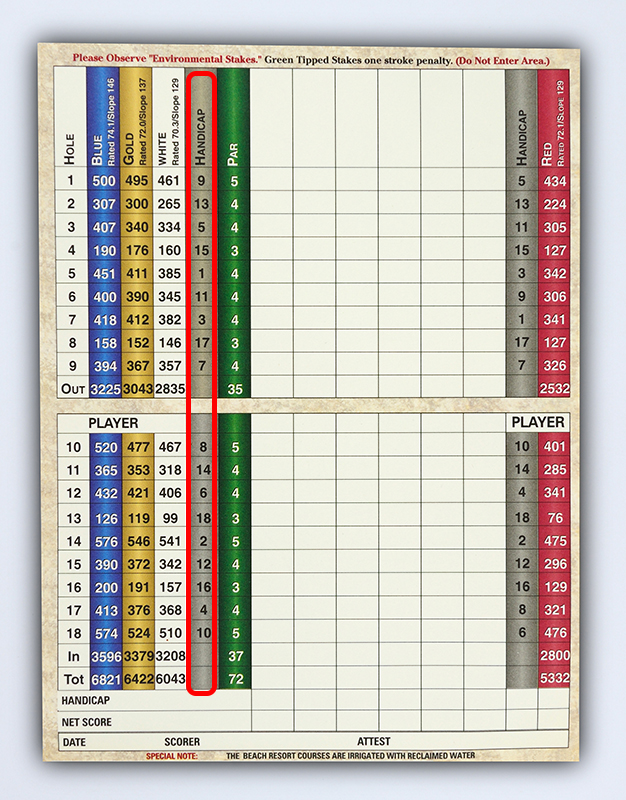What is a Golf Handicap? | Everything You Need to Know
Golf's handicap system leads to a lot of confusion for new golfers and golfers starting to take the game more seriously. In this guide, we'll explain the system and how to get an official handicap.
Bear with us if things seem confusing at first. By the end of this guide, you should clearly understand how handicap works in golf.
Covered in this guide:
- What is a Golf Handicap?
- Handicap Index®
- Average Golf Handicap
- Using Handicaps to Compete Fairly
- Calculate Golf Course Handicap
What is a Golf Handicap?
The USGA's Handicap System™ allows golfers of different ages, genders, and skill levels to fairly compete against each other on nearly any golf course in the world.
A golfer can get an official Handicap Index® through a USGA compliant golf club or through approved golf scoring apps like The Grint.
Handicap Index®, often referred to by golfers more simply as "handicap," is a numeric rating representing a golfer's ability based on their achieved scores relative to the difficulty of the course played.
A lower Handicap Index® indicates a more skilled golfer, while a higher handicap represents a less skilled golfer.
Your handicap symbolizes how many additional strokes you generally need relative to par. For example, on a neutral par-72 golf course, a 5-handicap golfer's course handicap would be 77.
Course Handicap represents the of the number of strokes a golfer needs to play to par from a specific set of course tees. The calculation factors in a player's Handicap Index® and a course's Course Rating™ and Slope Rating® to adjust the number of strokes that the player needs.
The higher the Course Rating™ and Slope Rating®, the harder the golf course plays.
A 12 handicap golfer at a reasonably easy local course of mine playing from the furthest tees would have a course handicap of 16. This same golfer playing from the championship tees of the much more difficult Kiawah Island Golf Resort's Ocean Course, host of the 2021 PGA Championship, would have a course handicap of 24.
Handicap Index®
Handicap Index® is not just an average of scores. It's an indication of how well you CAN play after taking into account the difficulty of the courses where you made your scores.
After changes made in 2020, the maximum handicap for all players is 54.0.
If you've submitted 20 rounds, your Handicap Index® will be calculated using an average of the Score Differentials of the eight best rounds out of all 20 rounds.
Score Differential is your score after factoring in course difficulty (Course Rating™ and Slope Rating®) and weather conditions (Playing Conditions Calculation (PCC)). In other words, it creates a standardized score so scores can be compared across different courses.
The USGA's Score Differential formula is:
(113 / Slope Rating®) * (Adjusted Gross Score - Course Rating™ - PCC Adjustment)
Fortunately for you as the player, you won't have to worry about these calculations. Once you submit your score, the club or app that manages your handicap will handle these calculations.
As mentioned above, only your eight best Score Differentials of the last 20 will be used to find your Handicap Index®. This is why we say Handicap Index® is more about how well you can play in your rounds rather than just a simple average.
However, there are safeguards the USGA considers to deal with extremely inconsistent golfers and exceptional rounds.
In regards to Score Differential and Handicap Index®, the USGA says:
This value may be adjusted due to built-in safeguards that are applied when:
- You submit an exceptional score, which is 7.0 strokes or better than your Handicap Index at the time the round is played, or
- Your 8 of 20 calculation is 3.0 or more strokes above your Low Handicap Index from the previous 365 days.
When these safeguards are applied, they will be indicated in your scoring record.
Again, while this may all be overwhelming, all you have to do as the golfer is submit your scores (including the course and tee boxes you played from). Your handicap index® will be updated the following day at midnight.
Average Handicap Index
According to the USGA, the average Handicap Index® for men is 14.2 and 27.5 for women.
The chart from the USGA below shows the Handicap Index® distribution for men:
 Handicap Index® Distribution for Men - Source: USGA
Handicap Index® Distribution for Men - Source: USGA
The chart below shows the Handicap Index® distribution for women:
 Handicap Index® Distribution for Women - Source: USGA
Handicap Index® Distribution for Women - Source: USGA
Keep in mind that these charts and averages only include golfers with an official handicap. We'd assume better golfers are more inclined to get an official handicap, while more casual golfers would be less likely to do so. If your handicap is on the worse (higher) end of the distribution, keep in mind that it probably would not be as bad if all golfers kept an official handicap.
Scratch and Better Golfers
You've likely heard the term "Scratch Golfer" thrown around if you've been playing the sport long enough.
A Scratch Golfer is a golfer with a Handicap Index® of 0.
It's also possible to have a handicap better than zero. The best golfers will have handicaps that begin with a "+" symbol, for example +2.
This means they'd actually be giving away strokes in relation to par rather than receiving them. For instance, a +2 golfer should score 70 on a neutral par-72 golf course.
PGA Tour Professionals can have handicaps as good as +6 or better.
Using Handicaps To Compete Fairly
If a 5-handicap and a 20-handicap golfer were competing straight up against each other, the 5-handicap golfer should almost always win.
That wouldn't be any fun for the worse golfer (20-handicap), and the 5-handicap would be unlikely to get the 20-handicap to play for anything too serious.
The handicap system allows better golfers to give an appropriate number of strokes to worse players.
Using Handicaps in Stroke Play
In stroke-play, our 5-handicap golfer could give the 20-handicap golfer 15 strokes (the difference between their two handicaps).
If the 5-handicap golfer shot a 78, the 20-handicap golfer would need to shoot a 93 to tie or a 92 to win.
- 5-Handicap Golfer - 78 - 5 strokes for Handicap Index® = 73 Net score
- 20-Handicap Golfer - 93 - 20 strokes for Handicap Index® = 73 Net score
Using Handicaps in Match Play
To use handicaps to compete in match play, you'd first find the difference between the two golfers' handicaps.
If we're using the same golfers from the previous example, the 5-handicap golfer would give 15 strokes to the 20-handicap golfer.
The 20-handicap golfer would get one stroke on the 15 most difficult holes (holes labeled 1-15 on the scorecard).
 Golf Scorecard Handicap Hole Rating
Golf Scorecard Handicap Hole Rating
If the 20-handicap golfer got a five on a par-5 hole that they were given a stroke and the 5-handicap golfer got a four, the hole would be tied. Instead, if they both got a five on the hole, the 20-handicap golfer would win.
In cases where a golfer receives more than 18 strokes in match play, they first get one stroke on every hole, then an additional stroke on the most challenging holes. For example, a golfer given 21 strokes would get two strokes on the three most difficult holes and one stroke on every other hole.
Calculate Golf Course Handicap
You can calculate your course handicap using the following formula:
Course Handicap™ = Handicap Index® X (Slope Rating® / 113) + (Course Rating™ - Par)
USGA Trademarks
TRADEMARKS: The terms Handicap System™, Handicap Index®, Course Rating™, Slope Rating®, and USGA® are trademarks of the United States Golf Association (USGA).
